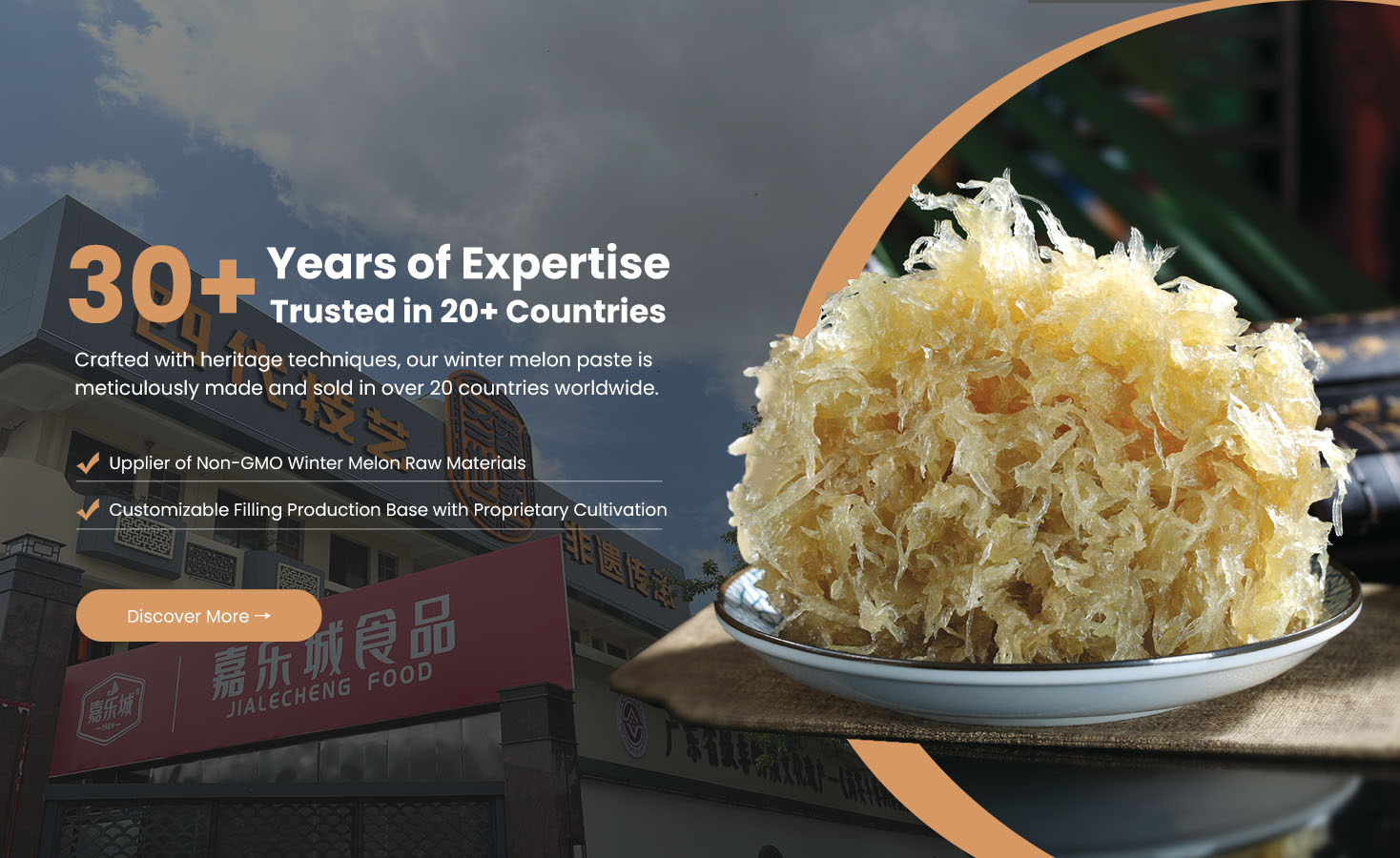Why Is Winter Melon Commonly Used As A Base in Asian Pastry Fillings?
Winter melon (Benincasa hispida), also known as white gourd or ash gourd, has been used for centuries as a key ingredient in Chinese and Southeast Asian pastries. Its mild flavor, soft texture, and versatility make it a perfect base ingredient for fillings in mooncakes, wife cakes, pineapple cakes, and other sweet or semi-sweet baked goods.
Modern food manufacturers such as Jialecheng Foods continue this tradition at scale, refining the natural advantages of winter melon through advanced processing—creating smooth, stable, and customizable fillings that serve as the foundation for a wide variety of desserts.
1. Neutral Flavor for Blending
Winter melon has a very mild, neutral taste, which allows it to absorb and carry other flavors easily. This makes it an ideal base material for fillings that combine:
Fruits (pineapple, mango, or citrus)
Nuts and seeds (sesame, peanut, walnut)
Aromatics (coconut, osmanthus, pandan, green tea)
Because the melon itself is not strongly flavored, it functions like a blank canvas — letting bakers adjust the sweetness, aroma, and texture for both traditional and modern recipes.
| Property | Benefit |
|---|---|
| Mild taste | Blends well with sweet, nutty, or floral flavors |
| Absorbs syrup easily | Retains added flavor uniformly |
| Low acidity | Compatible with fruit-based and dairy-style fillings |
2. Naturally High Water and Fiber Content
Fresh winter melon is about 90–92% water and contains a delicate fibrous structure that becomes translucent and gel-like when cooked with sugar.
This gives winter melon paste a distinctive soft, chewy mouthfeel that consumers associate with premium mooncakes and pastries. The natural fiber helps the paste:
Hold moisture without becoming runny
Maintain elasticity after baking
Achieve a glossy, dense texture
| Composition | Function in Paste |
|---|---|
| Water | Hydrates and softens during cooking |
| Fiber | Provides structure and chewiness |
| Pectin-like compounds | Create smooth, jelly-like consistency |
3. Excellent Texture Stability During Baking
When turned into paste, winter melon remains stable under high heat, which is essential for baked products like mooncakes that go through long oven times.
Its structure resists:
Oil separation (the paste doesn’t leak through pastry crusts)
Sugar crystallization (due to maltose or glucose addition)
Drying or cracking (retains moisture even after baking)
This makes it a technically reliable base for large-scale production where consistency and appearance matter.
| Baking Concern | winter melon paste Advantage |
|---|---|
| Heat exposure | Maintains soft texture without liquefying |
| Moisture loss | Retains water evenly through fibers |
| Product shelf life | Extends through controlled sugar content |
4. Cost-Effective Alternative to Traditional Pastes
Ingredients such as lotus seed or red bean paste are expensive to produce due to high raw material costs and long processing times.
Winter melon provides a cost-effective substitute or extender:
Cheaper and more abundant in tropical Asia
Yields more paste per kilogram of raw material
Blends easily with other ingredients for mixed fillings
Industrial producers often mix 30–50% winter melon paste with premium lotus or fruit pastes to reduce cost without compromising texture or taste.
| Paste Type | Common Use Ratio | Benefit |
|---|---|---|
| Lotus + Winter Melon | 60:40 | Balanced flavor, reduced cost |
| Red Bean + Winter Melon | 70:30 | Smoother texture, softer sweetness |
| Fruit Paste + Winter Melon | 50:50 | Adds body and moisture |
5. Long Shelf Life and Easy Processing
Winter melon’s natural composition makes it easy to process and preserve. When cooked with sugar and oil, it develops a stable texture with low water activity—ideal for packaging and export.
The paste can be vacuum-sealed and stored for months without spoilage.
It withstands freezing and reheating without breaking down.
Its high pectin and sugar content prevent microbial growth.
These properties make it suitable for industrial-scale food manufacturing and distribution.
| Property | Advantage |
|---|---|
| Low water activity after cooking | Prevents microbial growth |
| Stable texture | Maintains shape during shipping |
| Consistent yield | Predictable results for OEM/ODM production |
6. Nutritional and Natural Appeal
Winter melon is a natural plant ingredient that aligns with the growing global demand for clean-label and plant-based fillings. It is low in fat, cholesterol-free, and provides a source of dietary fiber.
This makes it suitable for markets that value:
Natural ingredients without artificial thickeners
Lower-calorie pastry options
Vegan-friendly formulations
| Nutritional Feature | Benefit |
|---|---|
| Low fat | Healthier for modern consumers |
| Natural fiber | Improves digestion and mouthfeel |
| Plant-based | Suitable for vegetarian and vegan markets |
7. Traditional and Cultural Significance
In Chinese culinary tradition, winter melon symbolizes purity and calmness, often featured in seasonal pastries and festival foods. It’s the classic filling for Guangdong-style wife cakes and a vital ingredient in Cantonese mooncakes, especially for Mid-Autumn celebrations.
The use of winter melon represents continuity between heritage craftsmanship and modern industrial innovation—a core philosophy of producers like Jialecheng Foods, which preserves authentic flavors while meeting export quality standards.
8. Summary: Why It’s the Preferred Base
| Reason | Explanation |
|---|---|
| Neutral taste | Easily adapts to any flavor or filling style |
| Smooth texture | Creates a glossy, elastic, bake-stable paste |
| Stable under heat | Maintains structure during high-temperature baking |
| Economical | High yield and lower raw material cost |
| Customizable | Mixes with lotus, fruit, nut, or bean pastes |
| Tradition + versatility | Rooted in classic pastry recipes yet suitable for modern innovations |
9. Conclusion
Winter melon is commonly used as a base in Asian pastry fillings because it offers the perfect combination of neutral flavor, stable texture, moisture retention, and cost efficiency. Its adaptability allows bakers and manufacturers to create fillings that range from classic to contemporary, all while maintaining the signature smoothness and sweetness consumers love.
Through modernized processing and quality control, Jialecheng Foods continues to showcase how this humble fruit remains at the heart of Asia’s pastry-making tradition — a natural, reliable foundation for creativity in every baked delight.




